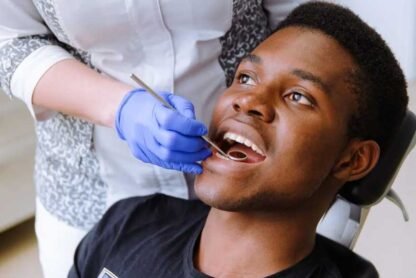1. Visual Inspection
An HVAC professional will inspect the components of the AC unit from the outside and the inside. They scan for evidence of wear, damage, or buildup on different parts. Some parts they check during an inspection include the condenser unit, evaporator coils, fan blades, and electrical connections. They also check for visible leaks, corrosion, or loose parts that would reduce the unit’s performance.
2. Thermostat Check
The air conditioning repair team tests the thermostat to confirm the room temperature is properly read and controlled. These tests prove whether a thermostat is calibrated correctly and reacts to temperature changes appropriately. The technicians will inspect the wiring connections of the thermostat to the AC unit to identify any loose or damaged wires. They will change the batteries or reprogram the thermostat to re-align the technology with the cooling unit.
3. Airflow Testing
Using specialized tools, HVAC professionals check air pressure and volume at different locations in the system to make sure there is proper airflow from each vent. The technicians look for blockages, leaks, fan motor issues, and airflow restrictions during airflow testing. Technicians sometimes inspect the blower wheel and motor to see if they’re clean and functioning properly enough to produce airflow.
4. Refrigerant Level Measurement
A standard AC repair service involves checking the refrigerant level to make sure it matches the manufacturer’s specifications. Technicians measure pressure on the high and low sides of the system using gauges. They identify coolant leaks with electronic detectors or by placing UV dye in the system. After fixing leaks, they recharge the system to the right amount of refrigerant.
5. Electrical Component Testing
HVAC repair teams examine and test capacitors, contactors, and relay switches on electrical system parts. After a visual inspection, they use multimeters to check electrical circuit voltage, amperage, and continuity. This alerts them to potential wiring damage, loose connections, or overheating components. They can then swap out any faulty parts so that the electrical system works correctly.
6. Condenser and Evaporator Coil Examination
An AC repair service provider inspects the condenser and evaporator coils for dirt, debris, and damage. They then use specialized solutions and tools to clean away buildup to improve the efficiency of the coils. Technicians can apply protective coatings to the coils to prevent corrosion and wear in the future.
7. Compressor Evaluation
The technicians measure the amperage draw of the compressor and listen for unusual noises. A thermostat signals the compressor to cycle on and off, so repair teams will check to make sure it’s cycling appropriately. Next, the repair team checks oil levels in the compressor and tests for shorts or opens in the electrical windings. The technician may recommend replacing or repairing a damaged or outdated compressor.
8. Ductwork Inspection
Leaks, damage, or insufficient insulation could reduce the efficiency of a duct system. Technicians may use cameras or smoke tests to find leaks or obstructions in a home’s ductwork. They also confirm that all ducts are sized correctly and that airflow is balanced between rooms and zones. Sealing, repairing, or replacing ductwork parts may be recommended to increase overall system performance.
9. Filter Replacement Check
A repair technician checks that the AC air filter is clean and that it is the correct size and type. They replace dirty filters to maintain proper airflow and keep indoor air clean. Depending on the unit’s use and environment, the technician will recommend a filter replacement schedule. They may also suggest installing a better-quality filter to increase your home’s air quality and protect your cooling system.
10. Drain Line Assessment
AC repair services involve checking whether the condensate drain line is leaking, clogged, or improperly installed. If the line is blocked, they inject compressed air or use special cleaning devices to improve flow. To prevent future buildup and clogs, algae tablets or UV lights should be installed in the drain pan.
Schedule an Air Conditioning Repair Service
Troubleshooting AC issues helps technicians find and solve different mechanical and technological issues. Look for an HVAC repair team that offers transparent pricing and a range of repair services. These professionals will maintain your AC unit to help it perform properly, boost energy efficiency, and lengthen its lifespan. Call a professional AC technician today to schedule a repair service.









